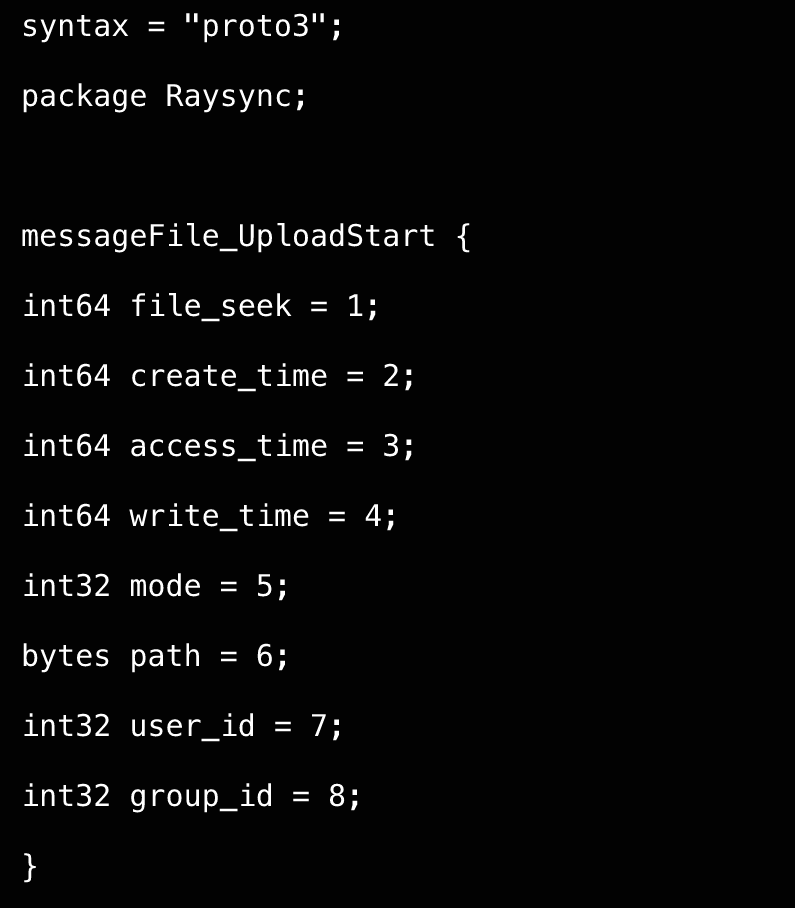How does Raysync utilize ProtoBuf for efficient data transfer?
March 26, 2024In today's rapidly developing information age, data transmission has become a crucial part of software development. Whether it's communication between services or interaction between an application and the server, both require efficient and reliable data transmission. However, traditional data formats often carry too much redundant information and lack scalability, making it challenging to meet increasingly complex data transfer needs.
Part 1: What is ProtoBuf?
Protocol Buffers, also known as ProtoBuf, is a cross-language, cross-platform, expandable serialized data structure format developed by Google. It can encode structured data into byte streams and decode it effectively.
The core idea of Protobuf lies in using protocols to define the structure and encoding method of data. You only need to predefine data structures, field types, and other information, then rely on the Protobuf compiler to generate the corresponding code. This allows you to easily implement data encoding and decoding. Based on binary encoding features, Protobuf can also achieve higher efficiency in data transmission and supports cross-language usage, greatly offering flexibility to developers.
Compared with XML and JSON, Protobuf has the following advantages:
-
Smaller data volume: As Protobuf employs binary encoding, it is generally 3–8 times smaller than XML and JSON, making it very beneficial for network transmission.
-
Faster encoding and decoding speed: Protobuf's encoding and decoding time is usually much faster than that of XML and JSON.
-
Easy to maintain and expand: Protobuf uses .proto files to define data models and formats. Without breaking the existing protocol, it can easily add or delete fields, achieve version upgrades, and ensure compatibility. Plus, Protobuf provides a strong type and stringent type-checking mechanism, allowing many low-level errors to be detected at compile time, making it easier to maintain compared to XML and JSON.
Part 2: How does RaySync use ProtoBuf?
As an enterprise-level transmission product, RaySpeed also uses protobuf for data transfer. The following are the general steps for using protobuf.
1. Using the language definition file (.proto) of Protobuf, you can define the data structure of the information to be transmitted, including the name, type, and other information of each field.

The above code includes definitions of two parts:
- Header definition: 'package Raysync' specifies the package name to prevent the definition of messages with the same class name. 'syntax = "proto3";' specifies the version of protobuf.
- Message structure definition: 'message File_UploadStart {}' defines a data structure before the start of a file transmission.
2. Compile protobuf: Using the protobuf compiler provided by the official, we can compile .proto files into code files in various languages (such as Javascript, C++, python).
In the front-end field, we can use the protobufjs library to compile .proto files into usable js files, with the command as follows:
![]()
3. Encoding with protobuf: Encoding refers to the conversion of data objects into binary data, which can then be transmitted over the network. By introducing the generated proto.js file, we can encode the object.
![]()
4. Decoding with protobuf: Decoding refers to the conversion of binary data back into data objects. The code is as follows:
![]()
Conclusion
In general, ProtoBuf is an efficient, lightweight, cross-language serialized structured data protocol, providing an excellent solution for large data transfer. Especially in complex and large systems, ProtoBuf not only performs exceedingly well but also greatly simplifies the development process. However, ProtoBuf is not a cure-all. For data that needs to be human-readable, data that requires real-time modification, or scenarios where transfer efficiency and data volume are not as critical, choosing a more universal JSON may be a good choice.
You might also like
Raysync News
January 8, 2024With the rapid development of the shipping industry comes the challenge of file transfer. How to efficiently solve the problem of file transfer is a top priority for the rapid development of the shipping industry.

Raysync News
November 3, 2022As the leader of high-speed large file transfer solution, Raysync announces its new key function of Admin Delivery Task. Click here to learn more!

Raysync News
November 21, 2022P2P transfer, known as peer-to-peer transfer, is an instant file transfer mode, which aimed to enable all clients to provide resources, including bandwidth, storage space, and computing capacity.